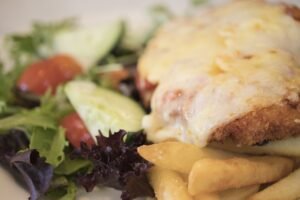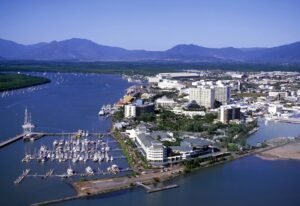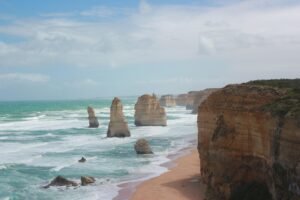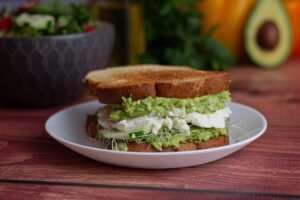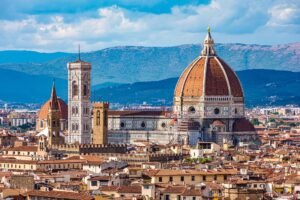Things to do in Manly, Sydney Australia - Beautiful Beaches & Corso.
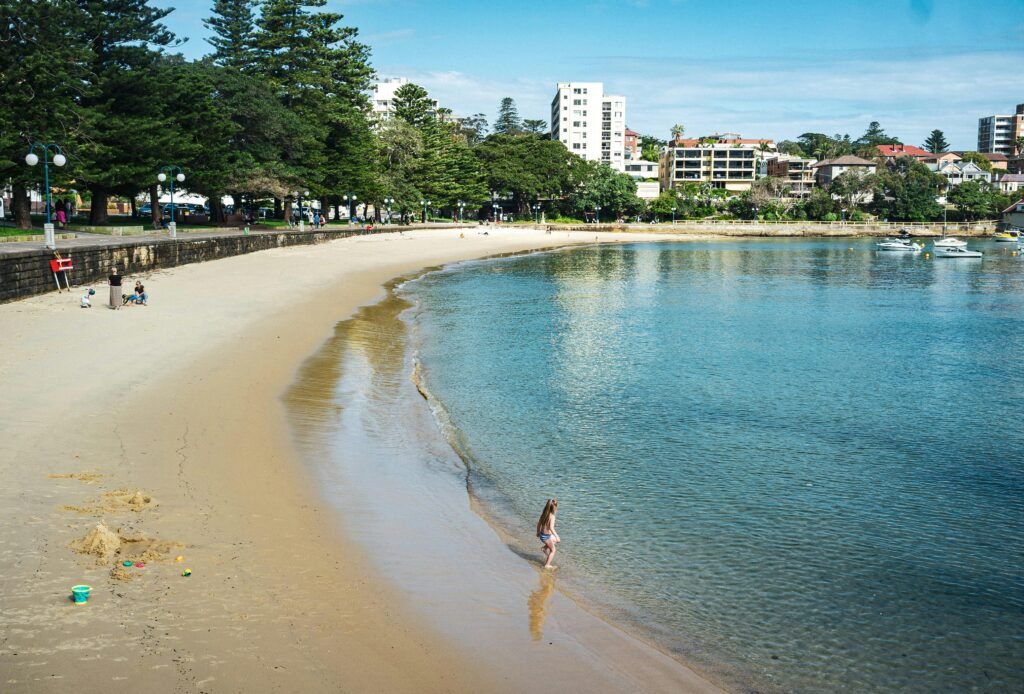
Welcome to Manly, a beach-Located in the suburbs of northern Sydney, in the state of New South Wales, Australia. I apologize for that. This walk was filmed during the week that the Manly Life Saving Club hosted the state championships. During the 4-day event, there are several competitions, including the life saver relay, surf race, board race, ironman race, Taplin relay, and open ski.
Men and women of all ages compete in their respective brackets. Right now, it is the female Ironman race. The Ironman race consists of swimming out past the breakers and back, then again on their ski (kayak), and finally once again on their boards. Here, you can see the girls grabbing their boards and heading back out again into the surf.
Manly Beach is actually three beaches in one: South Steyne, North Steyne, and the surf-friendly Queenscliff, where we are walking now. This is followed by rock pools and sandy beaches called Fairy Bower and Shelly Beach, which we will see later in this tour. There are also a number of beaches on the harbor side of the peninsula, including Collins Beach, Store Beach, Little Manly, East Manly Cove, West Manly Cove, Delwood Beach, and Fairlight Beach.
Explore the various beaches like South Steyne, North Steyne, and Queenscliff for surfing and sunbathing.
Manly is known for its iconic beach, which is popular for swimming, surfing, and other water sports. Norfolk Island pine trees are symbolic of Manly and are a prominent feature of both the ocean and harbor beaches. The beach is also home to the annual Australian Open of Surfing, a major international surfing competition.
Attend the Australian Open of Surfing if visiting during the event.
Manly was named by Captain Arthur Phillip for the Indigenous people living there, stating that “their confidence and manly behaviour made me give the name of Manly Cove to this place.” These men were of the Kay-ye-my clan (of the Darug-speaking Gayemaygal people). While scouting for fresh water in the area, Phillip encountered members of the clan, and after a kidnapping, he was speared in the shoulder by one of the clan as a punishment ritual. The progressively-minded Phillip ordered his men not to retaliate.
The beach is nearly 1 mile (1.6 km) long. On the left, you can see Shelly Beach in the distance. A little further down the beach is another competition, this time the open male surf boat race.
Watch the surf boat races or join a surf competition at Manly Beach.
Manly is connected to the rest of Sydney via ferry, making it a popular destination for tourists and locals alike. The ferry from Sydney takes about 30 minutes and arrives at the Manly Wharf located in Manly Cove on the harbor side of the town, which we will visit soon.
Take a scenic ferry ride from Circular Quay to Manly Wharf.
We are now walking along Ocean Beach. Here on the left, you will see a red and yellow flag, which designates that a lifesaving service is operating in this area. Surf Life Saving is a lifeguard organization in New South Wales with over 75,000 volunteer members.
Manly beach food list:
Manly’s Beachfront Dining:
Manly Wharf Bar, The Pantry Manly, and Hugos Manly.
The Corso and its Culinary Delights:
The Corso’s cafés, The Coffee Emporium or Barefoot Coffee. Australian meat pies.
Fresh Seafood at Manly Fish Market:
Manly Fish Market.
Shelly Beach Café:
Shelly Beach Café.
Manly Wharf and Surrounding Restaurants:
The Wharf Bar & Kitchen, and Bavarian Bier Café.
Local Pubs and Breweries:
The Ivanhoe Hotel or 4 Pines Brewery.
Sweet Treats and Desserts:
Gelatissimo Manly and Manly’s Bakehouse.
Farm-to-Table Dining.
Asian Cuisine:
Manly Thai or Yok Thai Sushi Train.
Relax and swim at designated lifeguard-patrolled areas of the beach.
The origins of Surf Life Saving New South Wales can be traced back to the actions of Mr. William Gocher at Manly Beach in September 1902. At the time, he defied the local law by bathing during the prohibited hours. There was a ban on daylight sunbathing at the time. Daylight bathing was first prescribed in 1833 in the Sydney Police Act, which banned it around Sydney Cove.
As surf bathing grew in popularity, its dangers just as rapidly became apparent. During the first official bathing season in 1903, 17 people drowned on Manly Beach. Small groups of experienced and regular surfers began to form themselves into lifesaving bodies to assist those who needed to be rescued from an unfamiliar environment. As these clubs grew in size and numbers, the need for a united front to raise funds and seek assistance from local and state governments resulted in the New South Wales Surf Bathing Association being formed on October 18, 1907.
Visit the Surf Life Saving Museum to learn about the history of lifesaving.
To keep our beaches safe, surf lifesavers patrol beaches from September to April. Each season, surf lifesavers spend over 650,000 voluntary hours patrolling most of the accessible beaches along the New South Wales coastline, giving back to the community in various ways.
Watch the Surf Life Saving Patrols in action on the beach.
The Northern Beaches Volleyball Association, Inc. (NBVA) was established here in Manly in 1989 as a non-profit organization dedicated to the enjoyment of sports in NSW. The club has eight permanent courts where we run beach volleyball competitions for all levels, from social to elite. Whenever there are no events on the courts, they are available to the public on a winner-holds-court challenge basis. These courts are fully owned and maintained by NBVA under arrangements with Northern Beaches Council and Manly.
Play or watch a volleyball game at Northern Beaches Volleyball Association courts.
The founder of Manly was an English-born Australian businessman named Henry Gilbert Smith (1802–1886). In the 1850s, he acquired two large parcels of land in the area and envisioned Manly becoming a seaside resort town. Smith built a wharf on the harbor side of Manly, which was completed in October 1855. In 1873, he sold his lease on the wharf to the operators of the ferries. During the 19th and early 20th centuries, Manly was one of Australia’s most popular seaside holiday resorts.
Visit the Manly Wharf for dining and sightseeing.
This is the Corso, a short street that joins the ocean beach side of Manly with the harbor side. Part of the Corso is a mall that allows outdoor dining for cafes and restaurants. The commercial area extends to surrounding streets, with more cafes and restaurants concentrated along the ocean and harbor shores.
Explore cafes and restaurants along The Corso and enjoy outdoor dining.
According to the 2016 census, there were 15,866 residents in Manly. Of these, 60.1% of residents were born in Australia.
In 1987, British novelist Lesley Thomson published the book Seven Miles from Sydney, a thriller about a female screenwriter who is murdered while jogging on Shelly Beach. This novel was a popular seller in the United Kingdom and well received in Australia.
Relax or jog along Shelly Beach, where scenes from the book were inspired.
Up ahead on the right is the Manly Congregational Church, Manly’s oldest church, established in 1862. This side street leads back over to the Corso.
Here on the left is St. Matthews, a vibrant Anglican church in the heart of Manly. Anglicanism is a Western Christian tradition that has developed from the practices, liturgy, and identity of the Church of England. Anglicans believe that there is one God who exists eternally in three persons—Father, Son, and Holy Spirit. Furthermore, they believe that Jesus Christ is completely God and also completely human.
Visit St. Matthews Anglican Church for a cultural: Here on our right is the Manly Town Hall. Across this street is the Manly Wharf, located in the Manly Cove of the North Harbor. From the Manly Wharf, you can take either the Manly Ferry or the Fast Ferry to the main ferry terminal in Sydney, called Circular Quay.
Sydney Public Transport and Credit Card Use:
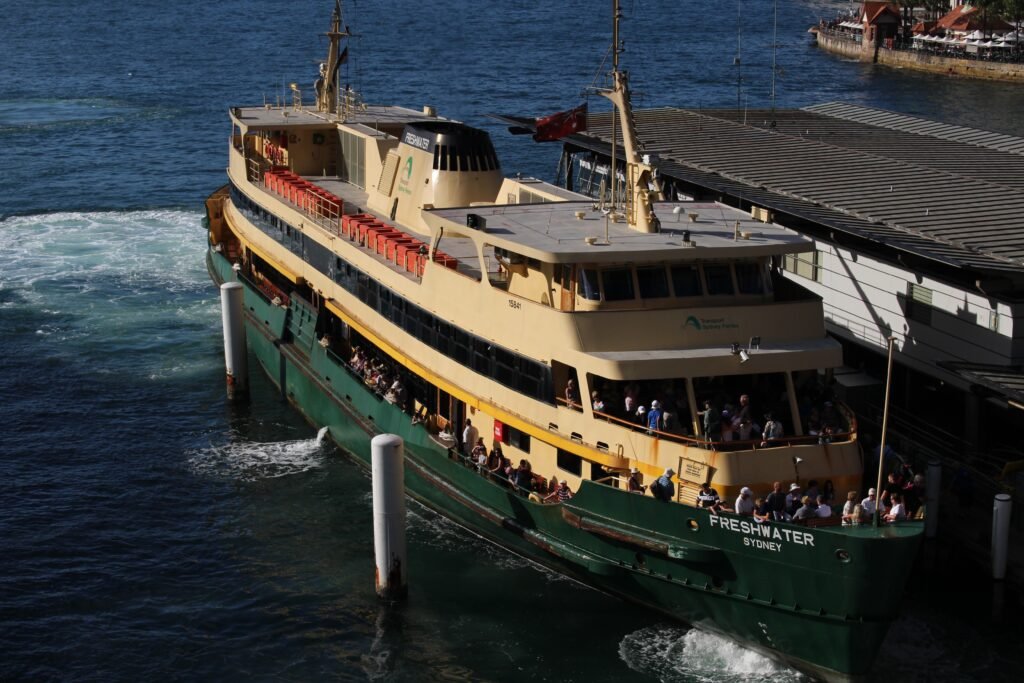
The Manly ferry takes about 30 minutes and costs approximately $6.58 or $9.87 AUD. All public transportation in Sydney can be paid for with a credit card. When using public transport, you need to TAP ON at the start of your trip and TAP OFF at the end to pay the correct fare. This means tapping your credit card on the contactless payment screen before boarding and then again when you depart.
The tap-on, tap-off system is very convenient. I spent two weeks in Australia and never visited an ATM.
Are you looking for a good credit card to use on your next international trip? I’ve been using the Capital One Venture Card for the past eight years on all my travels. The Capital One Venture Card has no international transaction fees, making it a great choice for travel. I’ve been very happy with it over the years.
When you take a bus in Sydney, remember to “tap off” before you get off to ensure you’re charged the correct amount.
Instead of using a credit card, many locals prefer the Sydney Opal Card. It works like a credit card but allows users to earn rewards for frequent use. With the Opal Card, you pay full price for the first eight trips in a week, and then all subsequent travel for the week is half-price.
There’s also a daily cap when using the Opal Card. The maximum daily charge is $10.74 ($16.10 AUD) for adults and $5.34 ($8.00 AUD) for kids. The weekly cap is $50 for adults and $25 for children. The biggest savings are on Sundays when you pay just $1.87 ($2.80 AUD) for unlimited travel all day!
The Opal Card itself is free. You load credit onto it to get started, with a minimum initial load of $13.34 ($20 AUD) for adults and $6.67 ($10 AUD) for children.
I didn’t get an Opal Card during my visit, assuming it cost money to start using the service. I could have saved a lot if I had gotten one. Let my mistake be your gain! 🙂
Even when you reach your Opal daily, weekly, or weekend travel caps, you must still tap on and tap off for every trip to maintain a valid ticket.
When taking the train, you only need to tap off at the end of your journey, not when transferring between trains.
What was that quote from Captain Arthur Phillip? Oh yes:
“Their confidence and manly behavior made me give the name of Manly Cove to this place.”
During my two-week visit to Australia, I filmed several new tours, including:
- An evening walk of Manly.
- The 7-mile (11 km) hike from Manly to the Spit Bridge.
- The 6-mile (10 km) coastal walk from Bondi Beach to Coogee Beach.
- A 12-mile (19 km) tour around Sydney’s central business district, including the Opera House, the Rocks, Darling Harbour, and the Royal Botanic Garden.
- A private catamaran tour around Sydney Harbour.
- All the ferry rides around Sydney Harbour.
- An evening walk around Sydney, from George Street to the Opera House.
I filmed all the walks with this camera, but only this walk has the occasional focusing issue—sorry about that!
We are now going to cross over to East Manly Cove Beach. This is the Fast Ferry to Circular Quay, which takes about 20 minutes—10 minutes faster than the regular ferry. Manly Fast Ferries also offer services to Darling Harbour and Barangaroo.
The Manly Wharf is an extremely popular area to enjoy a drink or meal, as you’ll see in my upcoming evening walk of Manly. From here, we are looking out into what is known as the North Harbour of Sydney Harbour.
In my opinion, the ferry ride between Manly and Circular Quay is a must for anyone visiting Sydney. During my 10-day visit, I stayed right here in Manly and took the ferry almost every day. During high tide, the water comes right up to the seawall.
Even though I stayed just a block away, I didn’t go swimming here at East Manly Cove Beach. I did swim at Manly Beach for about 20 minutes, but then I had to get ready to film another walk. 🙂
This was my first time visiting Sydney, so I spent two full days exploring the city on an e-bike before I started filming. I also walked the 7-mile hike from here to the Spit twice—once to learn the route and again with my camera the next day.
There are several smaller beaches around the corner. The area on this end of Manly is actually a national park, featuring cliffs overlooking Sydney Harbour.
Grab a bite at Guzman y Gomez or shop for essentials at Coles near Manly Wharf.
Here at the wharf is a Mexican restaurant called Guzman y Gomez, similar to Chipotle, where I grabbed a burrito several times after a long day of filming.
On my last night in Manly, I had the chance to meet the drummer of The Wiggles, an Australian children’s music group formed here in Sydney in 1991.
The drummer, Jack Gatto, is also a pretty amazing Elvis impersonator. He invited me to his concert the next night, but I had to pass since I had an early flight the following morning.
Here on the right is a grocery store called Coles, where you can find all the main essentials. If you’re looking for beer, wine, or liquor, you’ll need to continue a bit further down The Corso to Liquorland. This is Anita Gelato, a popular gelato shop that always seems to have long lines—but I think I’ll pass this time. 🙂
At the end of The Corso, you can choose to venture either north or south along the aptly named North Steyne and South Steyne beaches. We’ll head south.
Explore the Cabbage Tree Bay Aquatic:
Explore the Cabbage Tree Bay Aquatic Reserve and enjoy the natural beauty and wildlife in the area. Be sure to stay on the paths and respect the reserve rules.
The area between South Steyne Beach and Shelly Beach is known as the Cabbage Tree Bay Aquatic Reserve. It covers approximately 20 hectares and includes the entire bay, rocky shores, and beaches from the southern end of Manly Beach to the northern end of Shelly Beach Headland.
Cabbage Tree Bay Aquatic Reserve features seven main types of habitats:
- Sandy beaches.
- Rocky shores.
- Rocky reefs.
- Kelp.
- Seagrass beds.
- Open water.
- Sandy seabeds.
More than 160 species of fish have been recorded in the Reserve!
Here you can spot the lifeguards in their standard red-and-yellow uniforms. This is a ‘no-take’ Aquatic Reserve, which means:
#Fishing by any method is prohibited.
#Marine animals and plants cannot be harmed.
#Collecting marine organisms, dead or alive (including empty shells), is not allowed, as they often provide homes for living creatures.
Originally, Manly Beach was called Cabbage Tree Beach due to the many cabbage tree palms growing in the area. In 1898, this promenade to Fairy Bower was constructed above the sewer line to Cabbage Tree Bay.
surf lifesaving movement:
The surf lifesaving movement holds significant importance in Manly’s history. After daylight bathing became legal, large crowds flocked to Manly’s beaches, though not everyone understood the dangers of the surf.
Two fishermen, Eddie and Joe Sly, based at Fairy Bower, were the first lifesavers to patrol the beaches using their boat. In 1903, they staged a lifesaving demonstration to raise money for this essential service. Early surf carnivals, like the one you saw earlier, attracted thousands of visitors.
This path between Manly Beach and Shelly Beach is extremely popular. Since it’s flat the entire way, it’s great for wheelchairs as well. However, bikes are not allowed on the path.
Up ahead is the Fairy Bower Rockpool, built by local residents in 1929. This historic pool is one of many along the New South Wales coast, created during the rise of saltwater bathing’s popularity.
The sculptures along the rock edge are called ‘The Sea Nymphs’ or ‘The Oceanides’, crafted by artist Helen Leete.
Just ahead is Shelly Beach, part of Cabbage Tree Bay. With a maximum depth of approximately 40 feet (12 meters), Shelly Beach is a favorite spot for scuba divers and snorkelers, thanks to its shallow waters and abundant marine life.
The beach is well-equipped with showers, toilets, and a café. It also offers two free electric barbeques, making it an ideal spot for a family picnic. For a more formal dining experience, there’s a beachfront café called The Boathouse.
From here, the path leads to the Shelly Beach Walking Track. If you continue to the right, the trail ventures into the national park. However, we’re turning left to finish this tour with a stunning view back at Shelly Beach.
Thank you for joining me on this tour!



